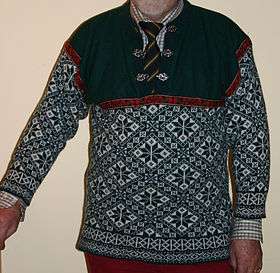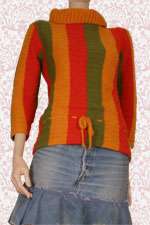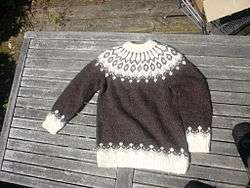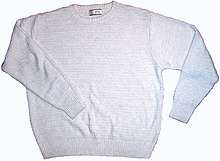Sweater
A sweater, also called a jumper in British English,[1] is a piece of clothing, typically with long sleeves, made of knitted or crocheted material that covers the upper part of the body. When sleeveless, the garment is often called a slipover or sweater vest.

Sweaters are worn by adults and children of all genders, often over a shirt, blouse, T-shirt, or other top, but sometimes next to the skin. Sweaters were traditionally made from wool but can now be made of cotton, synthetic fibers, or any combination of these.
Etymology
According to British dictionaries, "sweater" is used in British English in the same sense as in American English but "jumper" is commonly used instead (though some say that "sweater" is used for heavier ones worn for warmth).[2][3][1] Oxforddictionaries.com states that in British usage sweaters are always pulled over the head and jumpers are not necessarily,[4][5][6] whereas most or all other British dictionaries disagree and say that sweaters are not necessarily pullovers or even say that jumpers are always pullovers, i.e. never open in front.[7][8]
The OED gives "sweater" as appearing in 1882 and gives its definition as "A woollen vest or jersey worn in rowing or other athletic exercise, originally...in order to reduce one's weight; now commonly put on also before or after exercise to prevent taking cold. Hence a similar garment for general informal wear; a jumper or pullover"[9]
So according to most British dictionaries, British usage agrees with what American dictionaries describe as American English usage, according to which a sweater is either a pullover or a cardigan (which opens at the front). In other words, almost all British dictionaries include cardigans as a type of sweater but at least one includes cardigans as a type of jumper (i.e. most British dictionaries consider "sweater" – and at least one considers "jumper" – to be a hypernym for both pullovers and cardigans).
Types and design

The term "sweater" is a catch-all for a variety of knit garments. Although the term often refers to a pullover, it can also refer to a cardigan, a garment that opens and fastens down the front. Within either group, there is a great variety of design. Various necklines are found, although the V-neck, turtleneck and the crew neck are the most popular. The hemline is typically at hip height or slightly longer, just overlapping the waist of one's pants or skirt, but can vary significantly. It can range from just below the bust in women's garments to mid-thigh in either sex, or even longer in a knitted variation of the poncho shirtdress. The sleeve length is also variable, ranging from full-length or three-quarters to short-sleeved, cap sleeves or sleeveless. The front seam or opening of a cardigan allows for further different styles, such as a surplice or a bolero jacket. All hems may have various types of borders, such as picots, ribbing and frills.
Knitted fabrics are generally somewhat elastic and have a softer hand (feel or drape) than woven fabric, sweaters that are more tightly fitted or have a soft drape may conform well to the body without requiring tailoring necessary in a woven garment such as darts, flares and gores. Even when such shaping is used, it can be knit into the fabric itself, without requiring seams.
Another type is a sweater vest.
Nomenclature


A sweater with an open front fastened by buttons or a zipper is generally called a cardigan, but the nomenclature for other styles in different dialects can be quite confusing. In British English, a sweater may also be called a pullover, jumper or jersey. In the United States however, "jumper" refers to a style of women's sleeveless dress, worn over a blouse or shirt, and "jersey" refers to a knit shirt, especially if part of an athletic uniform. If sleeveless, such a garment may be called a "slipover" or "tank top" in British English, while "tank top" in US English refers to a sleeveless shirt or undershirt. In the U.S. a sleeveless sweater may also be called a sweater vest, especially if it has a V-neck and somewhat formal appearance resembling a formal vest, a garment known as a waistcoat in the UK In British English, "vest" refers to an undershirt. In South African English, a knitted sweater is always called a jersey, while sweater, when used, refers to a sweatshirt. In the sport of ice hockey, the top of a hockey player's uniform had traditionally been a sweater; and even though modern hockey uniform tops are more commonly a jersey they are typically referred to as a "hockey sweater," regardless of the style, but frequently, in the U.S. it is called a hockey "jersey".
| Article of Clothing | US | UK |
|---|---|---|
| Knitted garment covering torso and arms that is closed at the front | sweater, pullover | sweater, pullover, jumper |
| Knitted garment covering torso and arms that is open at the front | sweater, cardigan | sweater, cardigan, jumper |
| Women's sleeveless dress | jumper | pinafore |
| Cotton (or jersey) garment covering torso and arms that is closed at the front | sweatshirt | jersey |
| Athletic shirt | jersey | jersey, kit (refers to full sports uniform) |
| Sleeveless knit garment | sweater vest, slipover | slipover, tank top |
| Sleeveless undershirt | tank top | vest, singlet |
| Sleeveless formal garment | vest | waistcoat |
See also:
- List of American words not widely used in the United Kingdom
- List of British words not widely used in the United States
- List of words having different meanings in American and British English: A–L
- List of words having different meanings in American and British English: M–Z
Customary wear
Thin sweaters may be worn tucked into the waistband of trousers; but otherwise, men's sweaters are worn untucked. Nonetheless, some individuals, including some television and film actors, have been known for wearing tucked-in sweaters.[10]
Sweaters are a versatile item of clothing and can be worn on top of almost any outfit. Sports sweaters are often worn on tops of sports kit while traveling to or from a sports ground. Sweaters can be worn with a dress shirt underneath (and optionally a tie), which has the advantage of allowing the wearer to have the option of removing the sweater when it is uncomfortably warm and still looking presentable in many situations. Layering and the ease with which it allows for temperature regulation is a major benefit of the sweater as an article of clothing. Various methods have evolved for conveniently carrying a sweater, once removed. The three most common approaches are: around the waist (either loin cloth or knotted in front style) and over the shoulder.
In the late 20th century, the sweater increasingly came to be worn as an alternative to a shirt when finer materials made them more comfortable next to the skin.
Some people enjoy wearing Christmas-related sweaters around Christmas time to get into the festive spirit. Some women's sweaters are meant to be worn belted; a belt or drawstring is sometimes knitted into the sweater itself. Leggings are commonly worn with long sweaters or sweater dresses.
Care
Sweaters are often maintained by washing or dry cleaning and the use of a lint roller or pill razor. But airing (and rinsing in pure water if necessary) is considered better than washing with soap or another detergent, especially when not all of the natural oil (lanolin) has been removed from the wool. The use of detergent is in fact detrimental because it removes the lanolin, which helps the wool to repel and shed dirt as well as water. In fact sweaters made from unscoured wool, such as some Irish Aran jumpers, remain wearable even when wet.
Ice hockey
The uniforms that present day ice hockey players wear are sometimes referred to as "sweaters", although they nowadays usually more closely resemble the jerseys worn in other sports like soccer. This is because original uniforms were simply sweaters with the team's logo stitched on the front. However, as technology changed, so did the uniforms as actual sweaters absorbed too much moisture and became weighed down and cumbersome throughout the course of a game.
Sweatshirts
In 1920, Benjamin Russell Jr., a quarterback for the Alabama Crimson Tide Football team, was tired of the constant chafing and itching caused by their wool football uniforms.[11] Russell Jr. worked with his father, who owned a manufacturing company, to come up with a better option. At the time, Russell Manufacturing Company made garments for women's and children's knit shirts and undergarments.[12]
Knowing the durability and comfort of cotton they created a new practice jersey that was a modification of a ladies’ union suit top from thick cotton[13] that was produced throughout the factory. These loose, collarless pullovers – produced from women's undergarments to be used as men's football jerseys - would go on to become an iconic sweatshirt. Russell went on to create a new division of his factory, focusing solely on the production of sweatshirts, which became the Russell Athletic Company.
The sweatshirt's potential as a portable advertising tool was discovered in the 1960s when U.S. universities began printing their names on the medium. For students and parents alike, university names on sweatshirts became the preferred casual attire for exhibiting school pride. The sweatshirt, along with the T-shirt, provided a cheap and effective way of disseminating information on a mass scale. The T-shirt slogan fad of the seventies inevitably translated to sweatshirts. Recognizing the relative simplicity of customization and the power of clever graphics combined with catchphrases, sweatshirts became a vehicle for personal expression for both the designer and the person wearing them.[14]
Sweatshirts are arguably a type of sweater, but made of a fabric and cut similar to sweatpants. A sweatshirt worn with sweatpants forms a sweatsuit, an exercise outfit designed to raise the core body temperature and cause perspiration in order to lose body weight before a weigh-in for a weight-divided sport. It is fashioned out of a thick, usually cotton jersey material. Sweatshirts are also almost exclusively casual attire and not dressy as some other sweaters may be. Sweatshirts may or may not have a hood. A sweatshirt with a hood is now usually referred to as a hoodie, although more formal media still use the term "hooded sweatshirt".
References
- jumper in Collins English Dictionary: "a knitted or crocheted garment covering the upper part of the body"
- sweater in Cambridge English Dictionary: "(UK also jumper or pullover) a piece of clothing, typically with long sleeves and made from wool, that is worn on the upper part of the body"
- sweater in Collins English Dictionary: "a garment made of knitted or crocheted material covering the upper part of the body, esp a heavy one worn for warmth"
- "sweater". Oxforddictionaries.com. Oxford University Press. Retrieved 20 February 2019.
A knitted garment worn on the upper body, typically with long sleeves, put on over the head.
- "pullover". Oxforddictionaries.com. Oxford University Press. Retrieved 20 February 2019.
A knitted garment put on over the head and covering the top half of the body.
- "jumper". Oxforddictionaries.com. Oxford University Press. Retrieved 20 February 2019.
A knitted garment typically with long sleeves, worn over the upper body.
- "jumper". Cambridge English Dictionary. Cambridge University Press. Retrieved 26 May 2017.
a piece of clothing with long sleeves that is usually made from wool, is worn on the upper part of the body and does not open at the front.
- jumper in the Macmillan Dictionary: "BRITISH a warm piece of clothing, usually made of wool, that you pull over your head and that covers your upper body and arms"
- "sweater, n."., Oxford University Press, retrieved June 30, 2020 – via OED Online
- "Tucking in sweaters". GQ.COM. January 14, 2005.
- Gallagher, Jake (2013-08-28). "Dropping Knowledge: The Crewneck Sweatshirt". GQ. Retrieved 2017-09-19.
- "Sites-russell_us-Site". Russell US. Retrieved 2017-09-19.
- "A Brief Exploration of the Evolution of the Hoodie". Queensboro: Behind the Seams. 2015-02-11. Retrieved 2017-09-19.
- "Sweatshirt". LoveToKnow. Retrieved 2017-09-19.
External links
| Look up sweater in Wiktionary, the free dictionary. |
| Wikimedia Commons has media related to Sweaters. |
- Sweaters and waistcoats - thesaurus at Macmillan Dictionary